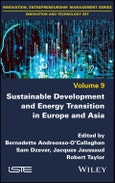Ranging from topics as diverse as city logistics, shareholder value and management practices, the EU-Japan Economic Partnership Agreement, China?s geopolitical insights, sustainable agricultural development in India and the empowerment of women in Vietnam via microfinance, this book addresses sustainable development policies in China and Southeast Asia from many different perspectives.
Table of Contents
Introduction xi
Robert TAYLOR
Chapter 1. The Role of Microfinance in Women Empowerment: Global Sustainable Perspectives in the Case of Vietnam 1
Long Bui THANH, Lucía MORALES and Bernadette ANDREOSSO-O’CALLAGHAN
1.1. Introduction 2
1.2. MF and women empowerment 3
1.3. Data and research methods 6
1.4. Research findings and discussion 10
1.4.1. Economic empowerment 11
1.4.2. Feminist and legal empowerment 14
1.5. Conclusion 16
1.6. References 17
Chapter 2. Is China’s Dependency on Coal a Threat to Its Economic Development? 23
Miroslava ZAVADSKA, Lucía MORALES and Bernadette ANDREOSSO-O’CALLAGHAN
2.1. Introduction 24
2.2. Coal consumption and environmental implications in China 26
2.3. Coal demand and economic growth in China 29
2.4. Methodological framework and findings 34
2.5. Conclusion 41
2.6. References 42
Chapter 3. China’s “Ecological Civilization”: Geopolitical and Geo-economic Insights 45
Daniel RAJMIL, Lucía MORALES and Bernadette ANDREOSSO-O’CALLAGHAN
3.1. Introduction 45
3.2. A tale of explosive economic growth 50
3.2.1. China’s economic model 51
3.2.2. Critiques to China’s growth strategy 54
3.3. China’s environmental degradation 56
3.4. The battle for “blue skies” and the BRI 59
3.5. Conclusion 60
3.6. References 61
Chapter 4. City Logistics Foundation: Japan at the Forefront 65
Gilles PACHÉ
4.1. Introduction 65
4.2. City logistics: issues and stakeholders 67
4.2.1. Economic and societal stakes 67
4.2.2. Diversity of stakeholders 70
4.2.3. A potential development for the wholesaler? 72
4.3. Japan: a favorable context for research on city logistics 74
4.3.1. Main areas of logistics innovation 75
4.3.2. From logistics innovations to theoretical formalizations 80
4.4. Conclusion 85
4.5. Acknowledgments 87
4.6. References 87
Chapter 5. The EU-Japan Economic Partnership Agreement as a Norm Model for Sustainable Development Issues in the Future EU FTAs in Asia 93
Erja KETTUNEN and Claes G. ALVSTAM
5.1. Introduction 94
5.2. The EU as a norm promoter in sustainable development 95
5.3. EU-Japan trade and investment imbalances 97
5.4. The context of the EU’s free trade negotiations with Asia 98
5.5. The EU-Japan EPA and sustainable development issues 100
5.5.1. The EU’s aims in the EPA negotiations 101
5.5.2. Trade and sustainable development issues 102
5.5.3. Other issues in the negotiations and reflections from the field 104
5.6. Conclusion 106
5.7. Acknowledgments 107
5.8. References 107
Chapter 6. The Relationship Between Shareholder Value and International Transfer of Environmental Management Practices 111
Kazuma MURAKAMI and Tatsuo KIMBARA
6.1. Introduction 111
6.2. Literature review 113
6.2.1. Shareholder value and environmental performance 113
6.2.2. Environmental management transfer 114
6.3. Methodology 115
6.3.1. Data 115
6.3.2. Analytical framework and hypothesis 116
6.3.3. Variables 118
6.4. Results of analysis 120
6.5. Discussion 123
6.6. Conclusion 125
6.7. References 125
Chapter 7. Global Crisis of Sustainable Development and Global Warming: A Case Analysis of Indonesia and Laos 129
Jasmeet LAMBA, Bhumika GUPTA and Sam DZEVER
7.1. Introduction 129
7.2. Background for climate change policy 130
7.3. Literature review 132
7.4. Research objectives 133
7.4.1. Major objectives of the research 134
7.5. Case studies 134
7.5.1. The case of Indonesia 134
7.5.2. The case of Laos 136
7.6. The 2015 Paris climate agreement 138
7.7. Regression analysis 139
7.8. Conclusion 140
7.9. References 142
Chapter 8. Southeast Asian Energy Transformation: Is It Enough and Sustainable? 145
Lucía MORALES and Bernadette ANDREOSSO-O’CALLAGHAN
8.1. Introduction 146
8.2. Southeast Asia’s energy strategy 147
8.3. Energy consumption - dependency on fossil fuels 150
8.4. The Southeast Asia energy dilemma 155
8.5. Conclusion 159
8.6. References 159
Chapter 9. Analyzing the Reasons for the Low Ratio of Female Researchers in Japan: An Exploration of the Issue of Diversity and Sustainability in Japanese Academia 165
Shiho FUTAGAMI
9.1. Current situation of female researchers in Japan 166
9.2. Research method 167
9.2.1. Survey 167
9.2.2. Profile of respondents 167
9.3. Analysis 168
9.3.1. Purpose of analysis 168
9.3.2. Reasons for the low ratio of female researchers 168
9.3.3. Reasons for the low ratio of female researchers in leading positions 171
9.3.4. Remedial actions for the low ratio of female researchers 173
9.3.5. Research performance to be evaluated in the recruitment process 176
9.4. Conclusion 179
9.5. References 180
Chapter 10. Sustainable Agricultural Development and Rural Poverty in India 183
Jasmeet LAMBA, Bhumika GUPTA and Sam DZEVER
10.1. Introduction 184
10.2. Objective and methodology of the research 185
10.3. Review of literature on agricultural development, credit flows, and rural poverty 186
10.4. Pattern of agricultural development in India 187
10.5. Classification of Indian States in context with CIAD and rural poverty 191
10.6. The model: relationship between agricultural development and rural poverty in India 192
10.7. Suggestions 194
10.8. References 194
Chapter 11. European and Chinese Consumers’ Attitude for Food with Reduced Use of Chemicals: Results from a Survey 197
Martina MAZZAROLO, Giacomo FERRARO, Ilda MANNINO and M. Bruna ZOLIN
11.1. Introduction 198
11.2. Background 199
11.3. Data and methodology 201
11.3.1. The sample 202
11.4. Results 204
11.4.1. Descriptive analysis on consumers’ behavior on food choice 205
11.4.2. Regression analysis 207
11.4.3. Descriptive analysis on different patterns of behavior on food choice between European and Chinese respondents 210
11.5. Discussion and conclusion 212
11.6. References 213
Conclusion 217
Bernadette ANDREOSSO-O’CALLAGHAN, Sam DZEVER, Jacques JAUSSAUD and Robert TAYLOR
List of Authors 219
Index 221








